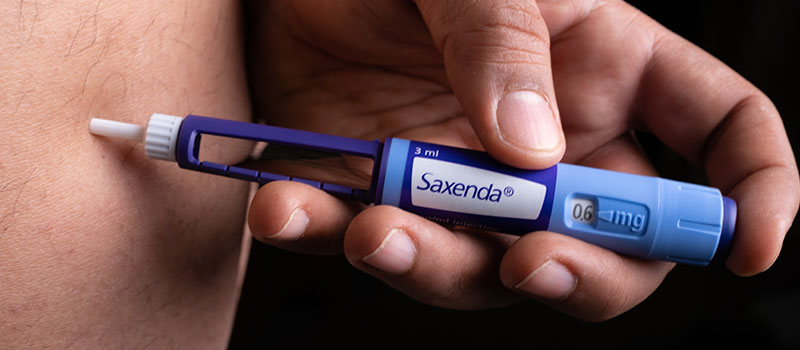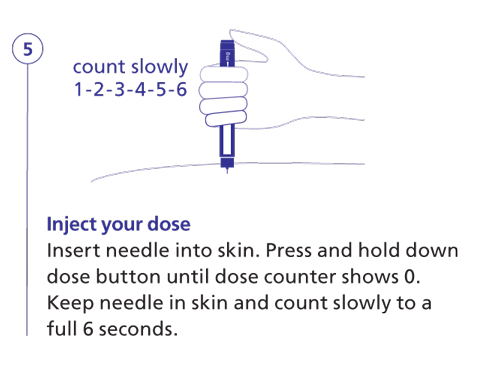What is Saxenda?
Saxenda is the brand name for the prescription medication liraglutide. It is used to help people who are overweight or obese lose weight when diet and exercise alone haven’t worked. Saxenda is only prescribed for people with a body mass index (BMI) of 30 or above or 27 or above for people with weight-related health problems like sleep apnea or high blood pressure. Saxenda is most effective alongside a calorie-controlled diet and exercise.
How does Saxenda work?
Saxenda works by making you feel less hungry. It mimics a hormone called glucagon-like-peptide (GLP-1), which tells your brain you’re full. This makes it easier to stick to a calorie-controlled diet, which can help you lose weight.
How long does Saxenda stay in your system?
Saxenda stays in your system for around 3 days. This is a lot longer than natural GLP-1 (the hormone that Saxenda mimics), which doesn’t last very long in the body. This is why we often feel hungry again soon after eating.
How long does Saxenda take to work?
Saxenda starts working straight away and can help to reduce your appetite within a few days. You should start to see weight loss results within 2-3 weeks.
After 17 weeks of using Saxenda, you can expect to have lost at least 5% of your starting weight. If you have not, your doctor may want to look at other treatment options.
How effective is Saxenda?
Saxenda is a highly effective treatment for helping you lose weight. A 2015 study monitored weight loss in 3,731 people with a BMI of at least 30 (or 27 with weight-related health problems). The participants were monitored for fifty-six weeks while being treated with daily injections of Saxenda combined with counselling on diet and exercise:
- three out of five participants achieved weight loss of 5% or more (an average weight loss of 12lbs)
- one in three participants achieved weight loss of 10% or more (an average weight loss of 23lbs)
- around 6% of participants achieved weight loss of 20% or more (an average weight loss of 47lbs)
Is Saxenda safe?
Saxenda is a generally safe medication, but it may not be suitable for everyone. Like all medications, Saxenda can cause side effects (listed below). Your doctor will decide if Saxenda is right for you.
How much weight can you lose on Saxenda?
You can expect to lose at least 5% of your starting weight after 17 weeks of treatment with Saxenda. How much weight you lose on Saxenda varies from person to person and depends on other factors like following a calorie-controlled diet and exercising regularly.
How to use Saxenda
Saxenda comes in the form of a pen injector and is injected just under the skin. Your healthcare provider will show you how to inject your medication correctly.
How do I inject Saxenda?
- Check you have the right medication, especially if you use any similar injectable pens.
- Your medication should be clear and colourless. If there is a change in colour or small bits in the liquid, do not use your medication and talk to your healthcare provider.
- Attach a new needle to the pen by tearing off the paper seal, pushing it onto the pen, and turning until it is on tight. Always use a new needle for each injection.
- Turn the dose selector until you have the correct dose.
- Remove both caps. Insert the needle into the skin at a straight (90 degree) angle
- Press the dose button and hold for 6 seconds.
- Remove the needle and dispose of it in your sharps bin. (This will be provided by your Saxenda prescriber or health authority).

Where can I inject Saxenda?
You can inject Saxenda into your thigh, abdomen, or upper arm. You should inject it into a different place each day to prevent damage or bruising to the area.
How long does a Saxenda pen last?
When you first start taking Saxenda, your pen will last for 17 days, and a pack of 5 pens for 44 days. When you reach the final dose of 3mg per day, your pen will last for 6 days and a pack of 5 pens for 30 days. A pen will last longer if you develop any side effects and need to slow down the rate that you increase your Saxenda dose.
Saxenda Dosage
The starting dose for Saxenda is 0.6mg per day, gradually increasing by 0.6mg each week over a week over 5 weeks to the maximum dose of 3mg per day.Saxenda pens come in packs of 5, and each pen contains 3mls of solution at a concentration of 6mg per ml.
The dose increases as follows:
| Week | Dose (mg) |
| 1 | 0.6 |
| 2 | 1.2 |
| 3 | 1.8 |
| 4 | 2.4 |
| 5 | 3 |
Saxenda Side Effects
Like all medications, Saxenda can cause side effects.
Very common sideeffects (may affect more than one in ten people) include:
- nausea (feeling sick)
- vomiting (being sick)
- headache
- diarrhoea
- constipation
These side effects usually go away on their own after a few days or weeks. If you are worried about side effects, or if they are getting worse or not going away, talk to your healthcare provider.
Other common side effects (may affect up to one in ten people) include:
- dizziness
- changes to your taste or a dry mouth
- low blood sugar
- passing more wind or belching
- indigestion
- stomach pain or bloating
- gallstones
- tiredness
- redness or inflammation at injection sites
Talk to your doctor if you have any of the following symptoms:
- stomach pain
- indigestion (heartburn)
- feeling bloated
- passing more gas (flatulence) or burping more than usual
- dry mouth
- feeling tired or having low energy
- change in your sense of taste
- feeling dizzy
- difficulty sleeping
- feeling shaky, sweaty, fast heartbeat, changes in vision, extreme hunger, nausea, weakness, or difficulty concentrating. These can be signs of low blood sugar and can come on very quickly. If you experience these symptoms, stop Saxenda, contact a doctor and follow your doctor’s advice about treating low blood sugar.
Uncommon side effects (may affect up to 1 in 100 people) include:
- pancreatitis
- dehydration, usually due to vomiting or diarrhoea
- delayed stomach emptying
- inflammation of the gallbladder
- allergic reactions such as skin rash
- malaise (feeling generally unwell)
- fast heartbeat
Rare side effects (may affect up to 1 in 1000 people) include:
- reduced kidney function or acute kidney failure. Symptoms may include peeing less than usual, feeling sick, feeling drowsy, bruising easily, and a metallic taste in the mouth.
Rarely, severe inflammation of the pancreas (pancreatitis) can occur while using Saxenda. Seek immediate medical attention if you experience:
- severe pain in the upper part of your abdomen that may radiate to your back
- nausea and vomiting
- fever
- fast heartbeat
Very rarely, a severe allergic reaction called anaphylaxis can occur. Seek immediate medical attention if you experience:
- raised red, itchy rash (hives)
- severe dizziness
- difficulty breathing
- swelling of the face, lips, and tongue
- collapse
Who can use Saxenda?
Saxenda may not be suitable for everyone. Always tell your doctor about any medical conditions, allergies, and other medications you are taking before using Saxenda. Saxenda is not safe for you to use if you:
- have ever had an allergic reaction to Saxenda or any of its ingredients (disodium phosphate dihydrate, propylene glycol, phenol, hydrochloric acid, or sodium hydroxide)
- are pregnant or breastfeeding
Saxenda has been shown to cause a type of thyroid tumour in rats and mice. Though there is no evidence that it causes the same in humans, this medication is not recommended for people with:
- thyroid cancer
- history of thyroid cancer
Tell your doctor immediately if you experience any of the following symptoms while using Saxenda:
- Difficulty swallowing.
- Growths or lumps in the neck.
- Hoarseness or loss of voice.
- Shortness of breath.
Saxenda may not be safe for you if you:
- have heart failure
- are over 75 years of age
- are taking other medications to help you lose weight
- are taking medications, or have an endocrine disorder that cause you to gain weight
- have problems with your liver or kidneys
- have inflammatory bowel disease
- have diabetic gastroparesis (delayed stomach emptying due to diabetes)
- have ever had inflammation of the pancreas (pancreatitis)
- have gallbladder disease or gallstones
- have ever had thyroid cancer
- have palpitations (awareness of your heartbeat or a fast heartbeat)
Interactions with other medications
Saxenda may interact with some other medications, meaning it may change how your medications work or make some side effects worse. Always tell your doctor about any other medications you are taking including herbal supplements and over-the-counter medications. Saxenda may interact with the following medications:
- Diabetes medications including insulin and oral sulfonylureas like glimepiride or glibenclamide.
- Blood thinners such as warfarin.
